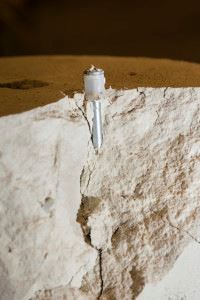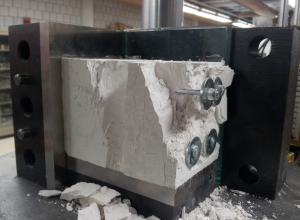Low oil prices make it even more important to reduce costs linked to the drilling and completion of oil wells. Experiments have shown that everyday nails can be used to provide an inexpensive way of stabilising wells.
Perhaps you’ve noticed the gigantic bolts used to stabilise tunnel walls along Norwegian mountain roads? Researchers have recently been looking into the possibility of downscaling this technology for use in reinforcing wellbore walls.

A powder-actuated nail gun is used to drive the nail into the rock sample. The aim is to develop a tool that can do the job according to a predetermined pattern along the entire length of the wellbore wall – which might be several kilometres long. Photo: Thor Nielsen/SINTEF.
Click to open
This may result in a rapid method of stabilising well sections at risk of collapse during drilling and production.
The approach is both quicker and less expensive than the alternatives such as so-called liners and casing that employ steel pipe and cement to support wellbore walls, or so-called screens that act as a kind of steel filter.
Experiments conducted during two years of research have shown that reinforcement using nails is very effective even in porous rocks such as sandstone and chalk. “Of course, the nails are much smaller than the bolts used in rock tunnels”, says SINTEF researcher and Ph.D. student Andreas Nicolas Berntsen.
“The bolts used in tunnels can be as much as a metre in length, whereas the nails we have tested for wellbore reinforcement are no more than 10 centimetres long.
Shooting the wall
Getting nails to penetrate wellbore walls is very different from the approach used in road tunnels. Whereas rock wall stabilisation is achieved first by drilling a hole and then inserting a metal bolt, Berntsen and his team intend to shoot the reinforcing nails right into the wellbore walls.
Facts about nail stabilisation:
- Borehole walls can become unstable during drilling, and there is a risk of collapse if the rock cannot withstand the stresses caused by the drilling process.
- During oil and gas production, hydrocarbons flow out of the porous reservoir rock and into the wellbore. If the wellbore wall becomes eroded, small particles of sand or chalk will enter the wellstream (production), leading to a number of problems.
- A reinforced wellbore wall will be less prone to instability and will inhibit sand and chalk production. Traditionally, casing, liners (cemented steel pipe) and screens are used. However, this project has involved research into the use of nail stabilisation to achieve the same result.
- The idea is that nails shot into the wellbore wall will act in a way similar to the traditional bolts used to stabilise rock tunnel walls.
- The nail stabilisation research project is being headed by SINTEF Petroleum Research and funded by BP Norge and the Research Council of Norway. Professor Rune Martin Holt at NTNU is affiliated to the project in a supervisory role.
“Our idea is to develop a tool that can be sent down into an oil well and then shoot a predetermined and close network of nails exactly where they’re needed”, explains Berntsen.
To date, the method has only been tested on rock samples in the lab using a powerful powder-actuated nail gun designed to drive nails into concrete. The tool manufacturer Hilti, which specialises in nail guns, is participating as a partner in the project. If all goes to plan Hilti will contribute towards the development of an entirely new tool specifically tailored to the oil industry.
BP Norge is sponsoring some aspects of this project, which is basically being funded by the Research Council of Norway, and will monitor progress to ensure that the technology can be applied in practice.
Potential for increased revenues
Tron Kristiansen is a rock mechanics advisor to BP in London and is also involved in the project. He sees two possible applications for this technology.
“The first is in reservoir sections, where it will be possible to use nails to replace liners and screens, making well construction less expensive and more effective”, he says. “It also seems likely that nails can help to inhibit the erosion of sand and chalk which is otherwise transported to surface in the well stream. These wells will be able to tolerate higher rates of oil production, and thus increase revenues”, says Kristiansen.
The other potential application is in very unstable sections of the well, most commonly encountered in geological formations located above the reservoir. If these sections can be reinforced using nails instead of traditional casing, it will be possible to continue drilling as soon as the nails have been shot into the wellbore walls.
Different rock types
Together with Professor Euripides Papamichos, who is formally responsible for the project, Berntsen is currently studying the deformation of rocks in different reservoirs with and without reinforcement using nails.
One of their challenges is that they are dealing with highly porous and relatively unstable rocks such as sandstone and chalk. This means that the wells, which are commonly drilled to several kilometres in depth, are at risk of fractures and collapse. For this reason a series of technical tests have been carried out at the University of Minnesota, which has equipment that can re-create downhole pressure regimes in laboratory samples, measure deformation, and study fracture development.

The University of Minnesota has equipment that can re-create downhole pressure regimes in laboratory samples, measure deformation, and study fracture development. The photo was taken during the experiments. Photo: SINTEF
Click to open
“This equipment is unique in that it also enables us to shoot nails into the samples under high pressure conditions”, explains Berntsen, who has been responsible for these experiments.
To date, results using the nails approach have been very positive:
- The well structure is more stable
- Existing fractures are prevented from expanding
- Loose rock fragments are prevented from obstructing the wellstream. So-called sand and chalk production are inhibited.
Calculating their way to the best solution
The researchers are also working together with the University of Cyprus, which specialises in numerical approaches to rock analysis.
“The measurements we make in the laboratory provide us with valuable data that researchers in Cyprus use in their numerical models”, says Papamichos. “This will provide us with a very comprehensive database when we have to make decisions about conducting our first practical experiments in an oil well”, he says.
Some of the work still left to be done involves determining minimum nail length, and how closely together the nails must be shot in order to give the optimal effect. The project will continue until 2016.

